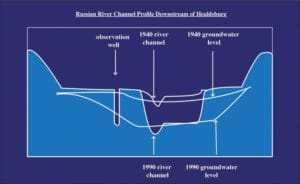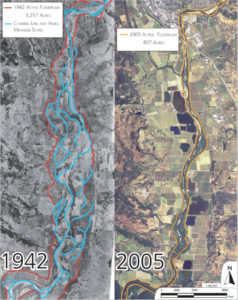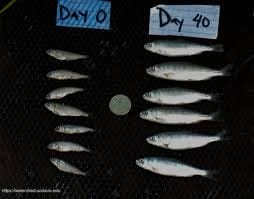If we had to point to the single biggest problem for the River, it’s the complete disconnection of our River from its former floodplains from Ukiah to Jenner. For a river not having a floodplain is like a car with no motor, it just won’t do the job we need it to. Historically rivers like the Russian River provided valuable “ecosystem services” to the community that we’ve lost almost entirely. Ecosystem services are services valuable to people that healthy natural systems provide for free and are worth millions to billions of dollars. Ecosystem services are things such as food for juvenile salmon, natural flood protection, groundwater recharge, water purification and climate regulation. Today we know those ecosystem services have been greatly diminished or lost before the word ecosystem
services was first used.
How did we lose potentially billions of dollars worth of free natural services? Simple, we cut the River off from spreading on to its floodplain during the rain season because of channelization, mining and thousands of dams large and small. These actions have resulted in the river’s bed down-cutting or incising up to 25 feet in some parts of the Russian River. The graphic below illustrates this dynamic by showing the riverbed elevation in the 1940’s and today.

At the same time as we have dropped the elevation of the bottom of the river, we have straightened and simplified the river and many tributaries with bulldozers. This river engineering eliminated the old river meanders, wetlands and about 80% or more of the area the river used to occupy. The aerial view graphic of the river in 1942 and in 2005 below shows that the Russian River lost 75% of the former river area, just between Healdsburg and Wolher Bridge. Put in other terms we have put the Russian River into a strait jacket that is 3 sizes too small and turned the Russian River into a simple ditch with trees on the sides. We have a car with no motor for a river.

Why is a straight deep channel a problem? It certainly provides more land for development for farming and other land uses. The reality is the loss of river area comes at a steep price – steeper than the hottest selling pinot now grown where the river used to be. Back in 1942, when the river rose it spread out and moved pollutants like silt into seasonally flooded areas where it wouldn’t harm fish or drinking water sources. In 1942 the spreading river would spread out and slow down and recharge our groundwater. This also provided natural flood control in slowing down water and spreading it out, today it all goes straight to Guerneville and increases flood heights rather then be temporarily stored in the floodplains. We know floodplains grow bigger salmon from studies that show salmon put in 3 foot deep pens in rice fields (pictured below) grow twice as fast as fish in the Sacramento River, and bigger juvenile fish lead to more returning spawners that re-build populations. Like any wildlife population, the biggest regulator for Salmon numbers on the Russian River is how much food the river makes. When you shrink the river by 75-80% it produces that much less food and therefore we have less salmon.

All these problems will get far worse with a changing climate. In the simplest terms, the hotter the air temperatures, the more extreme the weather is on both sides of the coin. When we have floods, they will be much bigger, and damage will be more costly. When we have droughts they will be longer and have more dire effects due to hotter temperatures. Water is a major part in seven out of ten jobs in our watershed so a prolonged ten-year plus drought would devastate not just our environment, but our economy as well. It’s obvious to many we have a very big problem so can we fix it? Luckily that answer is yes, we can get back many of those lost ecosystem services to help us survive more severe weather. This is why Riverkeeper, after fighting with gravel miners for decades, is now
working with them to restore former gravel pits back to floodplains. We’ve spent considerable time and effort over the last four years with Hanson Aggregates to come up with a plan to turn their brownfield pits into floodplains. This is a big deal as land along the river is very expensive but Hanson is willing to give the restored floodplain area – 350 acres to Sonoma County Regional Parks for a public park. A UC Davis study shows us that adding this much area will boost groundwater recharge by more than double. This is a win-win for the river and the community and increases the size of the middle reach by 30% in one project and feed up to 100,000 juvenile salmon! Closer to your home so you can help by slowing down and spreading out water in your garden so it sinks in to groundwater. The time to act and restore our floodplains is now before the next drought or next flood. When those bigger storms do hit us, it will be too late to act. What kind of future do we want in the watershed? A future of tipping from one disaster to another, or should we invest the time and money now to avoid disasters completely or reduce the impact to manageable levels?

